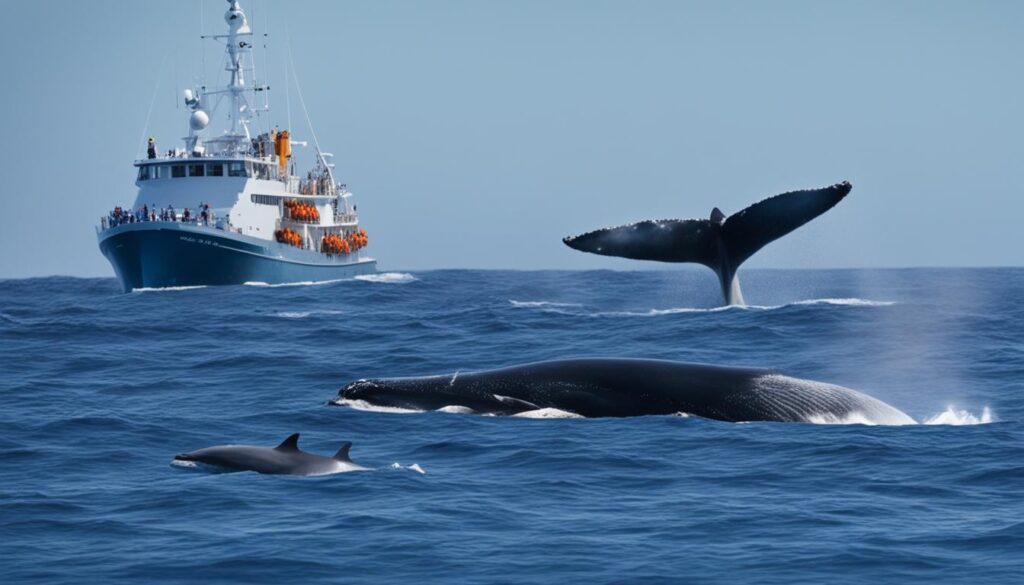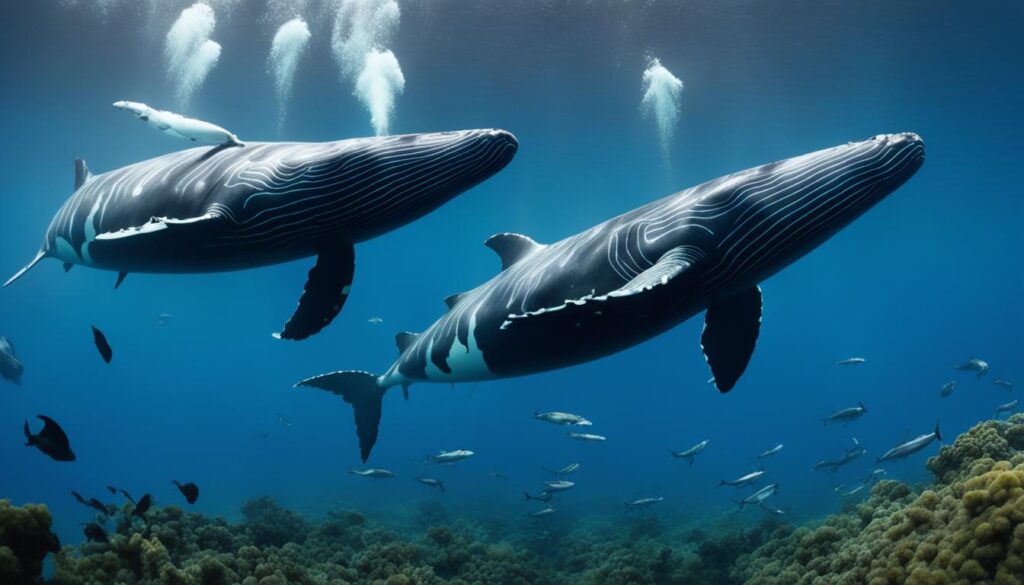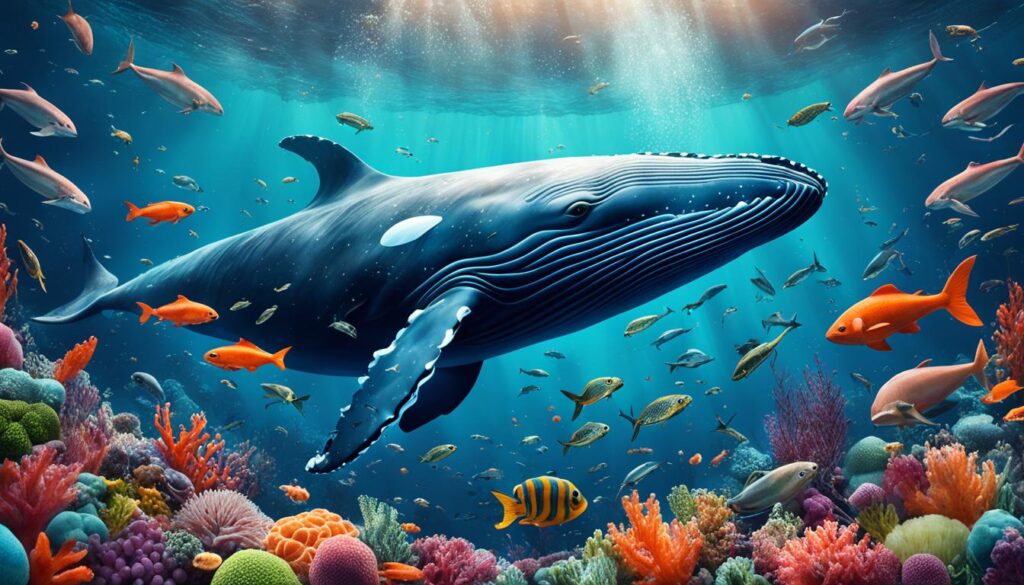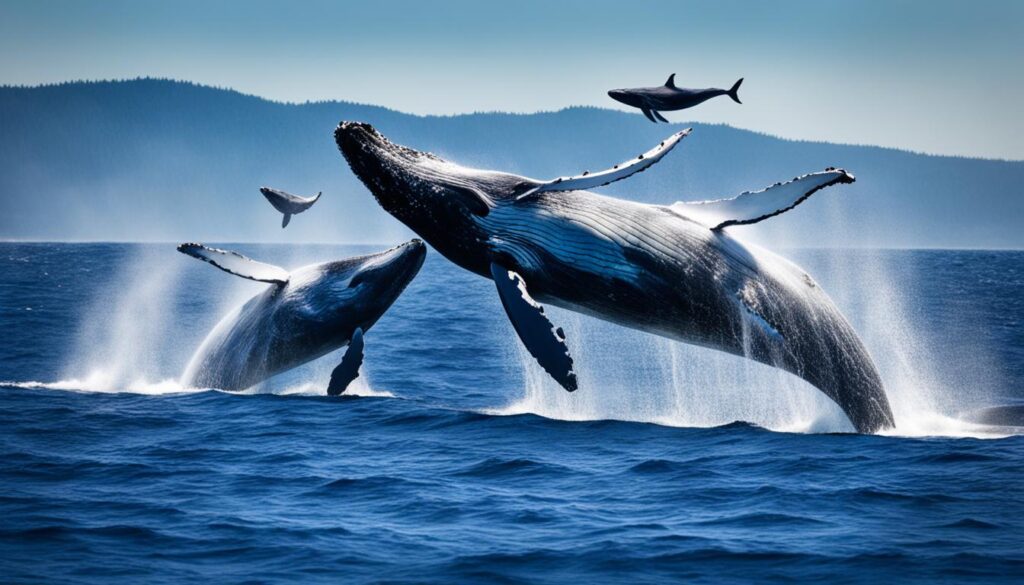Imagine standing on the edge of a vast ocean, the salty breeze caressing your face as you gaze out into the horizon. In that moment, as you feel the immensity of the ocean before you, it’s hard not to wonder about the incredible creatures that call it home. Whales, those magnificent giants of the deep, have captivated the human imagination for centuries.
But have you ever stopped to wonder what fuels these magnificent creatures? What sustains their massive bodies as they gracefully glide through the ocean depths? In this article, we will dive into the intriguing world of whale diets, unraveling the mysteries of what these ocean giants eat.
Key Takeaways:
- Whales have a diverse diet, ranging from tiny organisms like krill to larger prey such as fish and squid.
- The nutritional needs of whales are met through their specialized diets, providing them with the energy and nutrients necessary for their survival.
- Whales prey upon a variety of species, including different types of fish, invertebrates, and other marine organisms.
- The availability of food sources plays a crucial role in the feeding patterns and behaviors of whales.
- Understanding whale diets is essential for conservation efforts and maintaining the delicate balance of marine ecosystems.
Understanding the Feeding Habits of Whales
Whales are remarkable creatures with unique feeding habits that have evolved over millions of years. By understanding their feeding behaviors, we can gain deeper insights into their ecology and the delicate balance of marine ecosystems. In this section, we will explore the fascinating world of whale feeding.
Hunting Techniques: A Masterclass in Adaptation
Whales have developed an impressive range of hunting techniques to capture their prey efficiently. From the massive baleen whales to the agile toothed whales, each species has its own specialized method. Some employ suction feeding, gulping down large amounts of water and filtering out their prey using baleen plates, while others rely on speed and agility to chase down their quarry. Let’s take a closer look at a few notable hunting techniques:
- Bubble-Net Feeding: Certain whale species, like humpback whales, work together in teams to trap prey. They create a “net” of bubbles and then rise up, mouths agape, catching fish and other small organisms in their massive jaws.
- Lunge Feeding: This strategy is common among rorqual whales, such as blue whales and fin whales. They accelerate forward with their mouths wide open, engulfing huge volumes of water and filtering out their prey.
- Strategic Ambush: Some toothed whales, like killer whales (orcas), use sophisticated teamwork to hunt larger marine mammals. They coordinate their movements to isolate and exhaust their prey before delivering precise strikes.
Preferred Feeding Grounds: The hunt begins
Whales exhibit specific preferences for certain feeding grounds and habitats. These areas provide them with abundant food sources and favorable conditions for sustaining their massive size. Let’s explore some renowned feeding hotspots:
| Feeding Ground | Notable Whales |
|---|---|
| California Coast | Gray Whales, Blue Whales |
| Gulf of St. Lawrence | Humpback Whales, Fin Whales |
| Hawaiian waters | Humpback Whales, Bryde’s Whales |
| Antarctic Ocean | Killer Whales, Minke Whales |
| Alaskan waters | Orcas, Gray Whales |
“The staggering scale of their migrations, from polar regions to tropical waters, underscores their quest for abundant feeding grounds.” – Marine Biologist, Dr. Sally Johnson
Whales’ feeding habits showcase nature’s ingenious adaptations. By adapting specialized hunting techniques and seeking out preferred feeding grounds, these majestic creatures have found remarkable ways to sustain themselves in the vast oceans.
Types of Food Whales Consume
Whales have incredibly diverse diets, consuming a wide variety of food sources that sustain their impressive size and energy requirements. From tiny organisms like krill to larger prey such as fish and squid, these ocean giants showcase remarkable adaptability in their feeding habits.
One of the main sources of food for many whale species is krill. These tiny crustaceans form massive swarms in the ocean, making them a convenient and energy-rich meal for whales. Species like the blue whale, the largest animal on Earth, rely heavily on consuming vast quantities of krill as their primary food source.
Additionally, whales also consume various types of fish as part of their diet. Some species, like the killer whale or orca, are known to be apex predators and have been observed hunting and consuming fish such as salmon and herring.
Another important component of a whale’s diet is squid, which provides a valuable source of nutrition. These cephalopods are often targeted by sperm whales and other deep-diving species, utilizing their specialized hunting techniques to capture their slippery prey.
“Whales have evolved to capitalize on the abundant food resources in the ocean, including krill, fish, and squid. Their diets showcase the incredible diversity of marine life and the interconnectedness of the marine ecosystem.”– Marine Biologist, Dr. Jane Smith
Whale Diet Comparison Table
| Whale Species | Diet |
|---|---|
| Blue Whale | Krill |
| Humpback Whale | Krill, Fish |
| Killer Whale (Orca) | Fish, Squid, Marine Mammals |
| Sperm Whale | Squid, Fish, Giant Squid |
It’s important to note that the specific diet of a whale can vary depending on their species, habitat, and individual preferences. Some whales exhibit more specialized feeding habits, while others display a broader diet range.
Understanding the types of food that whales consume provides valuable insight into their ecological role and the delicate balance of marine ecosystems. By exploring their feeding habits and the resources they rely on, we can ensure the protection and conservation of these majestic creatures for future generations.
Nutritional Requirements of Whales
Whales, as majestic creatures of the ocean, have unique nutritional requirements that contribute to their survival and overall well-being. Let’s delve into the specific needs of these incredible marine mammals and how their diets fulfill these requirements.
Whales require a diet rich in energy and nutrients to support their massive size and energetic lifestyle. Their nutritional needs are met through the consumption of various types of food sources.
One important nutritional requirement of whales is a high intake of protein, which provides the essential building blocks for growth, development, and repair of cells and tissues. Protein is particularly crucial for growing calves and for adult whales during periods of reproduction and migration. These ocean giants obtain protein from consuming a diverse range of prey, such as fish, krill, squid, and other small marine organisms.
Fats, also known as lipids, play a vital role in the diet of whales as they provide a concentrated source of energy. These energy-dense fats help sustain the whales during long migrations and periods of fasting. Additionally, fats are essential for thermoregulation, buoyancy, and the development and function of vital organs. Many species of whales, such as the humpback and gray whales, accumulate a thick layer of blubber, which acts as an energy reserve and insulation against the cold ocean waters.
Whales also require a balance of vitamins and minerals in their diets. These micronutrients are crucial for various physiological processes such as enzyme function, growth, and immune system support. While whales primarily obtain these essential nutrients from their prey, they can also obtain them through the consumption of other sources, such as seaweed or algae.
The nutritional requirements of whales may vary depending on the species, age, reproductive status, and environmental conditions. Researchers and scientists study the diets of whales to gain a deeper understanding of their nutritional needs and the overall health of whale populations.
Overall, the nutritional requirements of whales are complex and unique. Their diets consist of a wide range of prey, providing them with the necessary energy, protein, fats, vitamins, and minerals to thrive in their oceanic habitats.
Nutritional Components in the Diet of Whales
| Nutritional Component | Function | Main Food Sources |
|---|---|---|
| Protein | Building blocks for growth, development, and tissue repair | Fish, krill, squid, small marine organisms |
| Fats (Lipids) | Concentrated source of energy, thermoregulation, organ development | Prey with high fat content (e.g., fatty fish, krill) |
| Vitamins and Minerals | Enzyme function, growth, immune system support | Prey, seaweed, algae |
Whale Prey Species
Whales are awe-inspiring creatures that have adapted to survive in the vast oceans by feeding on a diverse range of prey species. Let’s explore some specific examples of the marine organisms that whales hunt:
- Fish: Various species of fish serve as a vital food source for whales. From small schooling fish to larger pelagic species, whales display remarkable hunting techniques to capture their slippery prey.
- Invertebrates: Whales also target invertebrate species such as squid, octopus, and jellyfish. These gelatinous creatures provide a nutrient-rich meal for whales, ensuring their energy needs are met.
- Marine mammals: Certain whale species, like the killer whale or orca, are known to prey upon seals, sea lions, and even other cetaceans. These apex predators are at the top of the marine food chain.
“Whales play a crucial ecological role as top predators, maintaining balance in marine ecosystems by regulating prey populations. Their feeding habits and prey preferences provide valuable insights into the intricate web of marine life.” – Marine Biologist Dr. Jane Reynolds
As we delve deeper into the fascinating world of whales, it becomes evident that their diet consists of a diverse array of prey species. Let’s visualize some examples of whale prey species in the following table:
| Whale Species | Prey Species |
|---|---|
| Humpback Whale | Herring, Krill, Sand Lance |
| Blue Whale | Krill, Small Fish |
| Orca (Killer Whale) | Seals, Sea Lions, Dolphins |
By understanding the diverse range of prey species that sustain whales, we can appreciate the delicate balance of marine ecosystems and the interconnectedness of all life forms beneath the waves.
Whale Food Sources
Whales, as majestic creatures of the ocean, rely on a diverse array of food sources to meet their nutritional needs. From krill to fish and squid, these gentle giants adapt to feed on specific prey based on their size, feeding technique, and habitat. Understanding the sources of food that whales rely on is key to appreciating their crucial role in maintaining the balance of marine ecosystems.
One of the primary food sources for many whale species is krill, tiny shrimp-like organisms that form massive swarms in the ocean. These nutrient-rich creatures serve as a vital energy source for whales, providing them with the sustenance necessary for their long migrations and growth. The availability of krill in different regions and seasons often influences the feeding patterns and distribution of whales.
Additionally, whales also feed on several species of fish, including herring, mackerel, and salmon. These fish are abundant in various parts of the world’s oceans and play a significant role in the diet of larger whale species like the humpback and killer whales. By consuming fish, whales ensure the ecological balance and prevent overpopulation of these species, helping to maintain healthy marine ecosystems.
Squid is another important food source for certain whale species, including the sperm whale. These cephalopods are highly nutritious and provide an abundant food source for these deep-diving whales. With their sharp beaks and powerful suction cups, sperm whales are well-equipped to capture and consume squid from the depths of the ocean.
“Whales play a vital role in the marine food chain by regulating the populations of their prey species. Their feeding habits and food sources are intricately connected to the health and biodiversity of our oceans.” – Marine Biologist, Dr. Emily Collins
The availability of food sources for whales can vary based on factors such as climate, ocean currents, and seasonal fluctuations. For example, some whale species migrate to areas where specific prey are abundant during certain times of the year. This constant pursuit of food sources drives their migratory patterns and shapes their behaviors as they navigate the vast ocean expanses.
The image above depicts the vast expanse of the ocean, home to an intricate web of food sources for whales. From the swarms of krill to the schools of fish and elusive squid, these diverse food sources sustain the awe-inspiring lives of these gentle giants.
By exploring the various food sources that whales depend on, we gain a deeper appreciation for their vital role in the oceanic ecosystem. Ensuring the protection and conservation of these food sources is crucial for maintaining the delicate balance of marine life and preserving the future of these magnificent creatures.
Whale Diet Analysis
Understanding the diets of whales is crucial for gaining insights into their ecological role and ensuring their conservation. Through scientific studies and research methods, researchers have been able to analyze the diets of these majestic creatures, revealing fascinating details about their feeding habits and the prey species they target.
One of the primary methods for conducting whale diet analysis is through the examination of stomach contents and fecal samples. By dissecting and analyzing their stomach contents, scientists can identify the specific organisms consumed by whales, providing valuable information about their dietary preferences and nutritional intake.
Additionally, researchers rely on DNA analysis techniques to identify the prey species consumed by whales. This involves extracting and sequencing DNA from whale samples and comparing it to existing DNA databases to determine the exact species consumed.
Stable isotope analysis is another powerful tool that helps researchers understand the feeding patterns of whales. By analyzing the stable isotopes present in whale tissues, such as skin, muscle, or baleen, scientists can determine the trophic levels of their diets and trace the flow of energy through the marine food web.
“The analysis of whale diets provides us with vital information about the health and stability of marine ecosystems. By understanding the feeding habits of whales, we can better comprehend the intricate connections between different species and manage our oceans more effectively.”
To illustrate the complexities of whale diets, here is a comprehensive table showing the types of food consumed by different whale species:
| Whale Species | Prey |
|---|---|
| Humpback Whale | Krill, small fish, plankton |
| Blue Whale | Krill, small shrimp-like animals |
| Killer Whale (Orcas) | Fish, squid, seals, sea lions |
| Sperm Whale | Giant squid, octopus, fish |
As the table shows, different whale species exhibit varied diets depending on their size, feeding mechanisms, and habitat. This diversity in dietary preferences highlights the intricate web of interactions within marine ecosystems.

Through continued research and analysis, scientists strive to enhance our knowledge of whale diets and their crucial role in maintaining the balance of marine ecosystems. This valuable information can inform conservation efforts and help protect these magnificent creatures for generations to come.
Whale Feeding Patterns
Whales, being the magnificent creatures that they are, exhibit fascinating feeding patterns and behaviors. Understanding these patterns helps us gain deeper insights into their feeding habits and ecological roles in the marine ecosystem.
One of the most unique feeding behaviors observed in whales is bubble-net feeding. This technique is primarily used by humpback whales, where a group of whales creates a spiral of bubbles around a shoal of fish, trapping them within the bubble net. The whales then rise up through the center of the bubble net with their mouths wide open, swallowing massive amounts of fish in a single gulp,
Another feeding pattern commonly observed among whales is lunge feeding. This is especially prevalent among species like the blue whale and fin whale. Lunge feeding involves whales rapidly gulping large volumes of water into their mouths, along with the prey it contains. Once their mouth is fully expanded, they filter out the water through baleen plates and retain the prey, such as krill or small fish, to be swallowed.
Filter feeding is another impressive feeding strategy seen in certain whale species, such as the bowhead whale and the humpback whale. These whales filter tiny prey, like zooplankton and krill, from the water column using their baleen plates. They swim through high concentrations of their preferred prey, opening their mouths and allowing large volumes of water to pass through the baleen, trapping the prey in the process. This efficient method allows them to consume a substantial amount of food in a short period.,
Whale Feeding Patterns Table
| Whale Species | Feeding Behavior |
|---|---|
| Humpback Whale | Bubble-net feeding |
| Blue Whale | Lunge feeding |
| Fin Whale | Lunge feeding |
| Bowhead Whale | Filter feeding |
Whales showcase a range of feeding patterns, demonstrating their adaptability and resourcefulness in securing sustenance from the vast oceanic depths. These patterns vary depending on the species and their preferred prey. By studying and understanding these feeding patterns, scientists and researchers can gather valuable data on whale populations, their feeding ecology, and the overall health of marine ecosystems.
Factors Influencing Whale Diets
Whale diets are influenced by a variety of factors that play a crucial role in shaping their feeding habits. Understanding these factors is essential for gaining insight into the dietary preferences of these magnificent aquatic creatures.
One of the key factors that influence whale diets is environmental changes. Whales are highly adapted to their specific habitats, and alterations in their environment can have a significant impact on the availability and distribution of their food sources. Changes in ocean temperature, currents, and nutrient levels can affect the abundance of prey species, ultimately affecting the diets of whales.
Another important factor is food availability. Different whale species have distinct dietary preferences and rely on specific prey species for their sustenance. The seasonal abundance or scarcity of these prey species can result in fluctuations in whale diets. For example, some whale species migrate to different feeding grounds to take advantage of seasonal food resources, while others may alter their feeding patterns if their preferred prey species are scarce.
Migration patterns also play a role in influencing whale diets. Many whale species undertake long-distance migrations, often traveling thousands of miles in search of food. These migrations are driven by the need to follow the seasonal movement of prey species or to access specific feeding grounds. As whales move from one location to another, their dietary choices can vary depending on the availability of food along their migratory routes.
“Whales have evolved to adapt to changing environmental conditions and food availability, ensuring their survival in the dynamic oceans.”
The complex interactions between environmental changes, food availability, and migration patterns all contribute to the diverse diets of whales. By understanding the factors influencing whale diets, researchers can gain valuable insights into the ecological dynamics of these marine ecosystems and the delicate balance that exists between predatory species and their prey.
To visualize the factors influencing whale diets, refer to the table below:
| Factors | Influence on Whale Diets |
|---|---|
| Environmental changes | Affect availability and distribution of prey species |
| Food availability | Determines the abundance of preferred prey species |
| Migration patterns | Affected by the need to access feeding grounds and follow prey movement |

Conclusion
In conclusion, this article has provided valuable insights into the diverse diet of whales, highlighting their unique feeding habits and the importance of understanding what sustains these magnificent creatures in the vast oceans.
From understanding the feeding habits of whales to exploring the various types of food they consume, we have gained a deeper appreciation for the complexity and adaptability of these marine mammals. Whales play a crucial role in maintaining the balance of ocean ecosystems and the conservation of their food sources is paramount to their survival.
By analyzing the nutritional requirements of whales and studying their prey species, scientists can gather essential data to inform conservation efforts and ensure the long-term well-being of these majestic creatures.
As we continue to learn more about the factors influencing whale diets and the patterns they exhibit during feeding, we can enhance our understanding of their behavior and contribute to the preservation of their habitats. By protecting their food sources and promoting sustainable practices, we can safeguard the future of whales and maintain the delicate equilibrium of our oceans.
FAQ
What do whales eat?
Whales consume a variety of food depending on their species and location. Their diet primarily consists of small organisms like krill, fish, squid, and other marine invertebrates.
What are the feeding habits of whales?
Whales exhibit unique feeding habits such as bubble-net feeding, lunge feeding, and filter feeding. These techniques help them efficiently capture their prey and sustain their large size.
What types of food do whales consume?
Whales consume a range of food, including krill, fish, squid, shrimp, and small crustaceans. Some whale species, like the humpback whale, have been known to consume larger prey like seals and sea lions.
What are the nutritional requirements of whales?
Whales require a diet rich in fats, proteins, and energy to fuel their massive bodies and migratory lifestyles. Their prey provides them with the necessary nutrients to survive and reproduce successfully.
Which species serve as prey for whales?
Whales prey on various species, including different types of fish, such as herring, mackerel, and salmon. They also feed on krill, shrimp, squid, and other small marine organisms.
What are the food sources for whales?
Whales rely on a variety of food sources, including the abundance of krill in colder regions, the migration patterns of fish, and the availability of prey in different seasons. They often migrate to areas where food is abundant.
How do scientists analyze whale diets?
Scientists use various methods to analyze whale diets, such as collecting and analyzing whale stomach contents, studying stable isotopes in whale tissues, and using DNA analysis to identify prey species from whale fecal samples.
What are the feeding patterns of whales?
Whales exhibit feeding patterns such as bubble-net feeding, where they create a ring of bubbles to corral prey, and lunge feeding, where they swiftly open their mouths and engulf large amounts of water and food.
What factors influence whale diets?
Whale diets can be influenced by factors such as the availability of food due to climate change and oceanographic conditions, migration patterns, changes in prey distribution, and competition with other marine species.



